Tadacip dosages: 20 mg
Tadacip packs: 10 pills, 30 pills, 60 pills, 90 pills, 120 pills, 180 pills, 270 pills, 360 pills
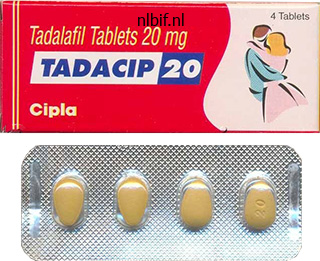
Buy tadacip 20 mg cheap
The and subunits kind distinct heterodimers with through extremely conserved residues at the dimerizing interface purchase erectile dysfunction drugs tadacip 20 mg without prescription. Each of those molecules incorporates a number of amino acid sequence motifs that may mediate cellular activation impotence treatments natural buy tadacip 20 mg otc. Both of the tyrosines in this motif are completely required to mediate signal transduction as mutation of either fully prevents the mobilization of free calcium or cytolytic activity erectile dysfunction genetic proven 20mg tadacip. There are additionally pairs of tyrosines present within the cytoplasmic domains of the impotence from priapism surgery purchase 20 mg tadacip fast delivery, and chains. However, using other detergents, such as digitonin or Triton-X100, revealed 4 other proteins. In mouse T cells, the -chain can disulfide bond with a minor variant called the (eta) chain. In addition, negatively charged transmembrane residues (D for aspartic acid and E for glutamic acid) and putative phosphorylation sites are shown. There are 50 totally different J-region gene segments upstream of the C-region in the murine locus. At least eight of these J-regions are nonfunctional because of in-frame cease codons or rearrangement and splicing indicators that are likely to be defective. In each the murine and human loci, the C, J, and two D gene segments are located between the V and J gene segments. In the murine system, there are two J and two D gene segments on the 5 facet of C and the C exons are roughly 75 kb upstream of the C gene and approximately eight kb upstream of essentially the most 5 identified J gene segments. That is, in mice one regularly finds V D1, D2, and J rearrangements,86 and in humans V, D1, D2, D3, and J. An implicit attribute of the / gene locus is that a rearrangement of V to J deletes the whole D-J-C core of the -chain locus. This association is preserved in all higher vertebrate species which were characterised thus far (mouse, human, rooster, frog). The two C coding sequences are identical within the mouse and almost so in people and other species. However, the J clusters have comparatively unique sequences, and thus this can be a mechanism for growing the variety of J gene segments. Similar to the case of V5, a single V gene, V14 is situated 3 to C-regions and within the opposite transcriptional orientation, thus rearrangements involving V14 happen by way of inversion. In addition to enhancers, there additionally appear to be "silencer" sequences 3 of C122,123 and within the C1 locus. In early fetal thymocytes, rearrangements of V 5 and V 6 genes predominate, and the ensuing V three + and Vg4 + cells migrate to the pores and skin or reproductive tissue, respectively. Later in ontogeny, V4 and V 7 rearrangements predominate, and cells expressing these V areas migrate from the adult thymus to the secondary lymphoid organs and the intestinal epithelium. The sequences of the 2 human C regions are very related total and solely differ significantly in the second exon. In C 2, this exon is duplicated two or three times and the cysteine that forms within the interchain disulfide bond is absent. The organization of the murine chain genes could be very totally different than that of the human genes in that there are three separate rearranging loci that span about 205 kb. The C4 gene differs significantly in sequences from the other C genes (in 66% overall amino acid identity). The sequences of J1 and J 2 are equivalent at the amino acid stage, whereas J4 differs from J1 and J 2 at 9 out of 19 amino acid residues. Interestingly, some V genes are rearranged and expressed preferentially during T-cell ontogeny and in different grownup tissues as well. Instead, the grownup thymus produces T cells expressing V1, V 2, V4, and V 7 gene segments with highly diverse junctional sequences. Moreover, T cells that localize to the secondary lymphoid organs tend to express V4, V1, and V 2, whereas those that localize to the intestinal epithelium express V 7. Thus, the two parts not solely exhibit functional redundancy in thymocytes but in addition have distinctive features in other settings. Allelic Exclusion In Igs, usually just one allele of the heavy chain locus and one of the mild chain alleles is productively rearranged and expressed, a phenomenon termed "allelic exclusion. In antibodies, this form of mutation usually raises the affinities of antigen particular Igs several order of magnitude, usually from the micromolar (10-6 M) to the nanomolar (10-9 M) vary. The pairing of random V areas generates the combinatorial diversity listed as "variable area combos.
Syndromes
- Certain sexually transmitted diseases including HIV
- Alcoholism that is present for 10 years or more
- Your heart surgeon may make a 2-inch to 3-inch-long cut in the right part of your chest near the sternum (breastbone). Muscles in the area will be divided. This lets the surgeon reach the heart. A small cut is made in the left side of your heart so the surgeon can repair or replace the mitral valve.
- Hearing problems
- Carcinoid syndrome
- Amikacin: greater than 25 mcg/mL
- Feeding often and pumping milk to prevent engorgement of the breast
- Rash over the entire body that often contains blood (hemorrhagic)
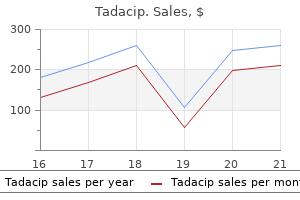
Generic tadacip 20mg overnight delivery
Another essential development because the publication of the last version of this chapter is the elevated emphasis on the research of the human immune response to parasitic infection impotence drugs over counter buy tadacip 20mg fast delivery. The most notable advances have occurred in the subject of malaria erectile dysfunction treatment bodybuilding 20mg tadacip fast delivery, which advantages from a wealth of scientific material and the power to use peripheral blood as a physiologically related source of immune cells erectile dysfunction drugs walmart purchase tadacip 20mg mastercard. The study of human malaria is yielding novel insights into the character of B-cell effector and reminiscence responses to the parasite as well as the function of innate cellular function in regulating illness consequence erectile dysfunction biking tadacip 20 mg online. Nevertheless, having a defined antigen vaccine during which a minimum of a proportion of the immunized individuals turn out to be protected provides a rare opportunity to identify correlates of immunity to malaria triggered by a single immunogen via the use of a "methods vaccinology" approach. It is hoped that thrilling new approaches and alternatives of this kind will deliver us nearer to our ultimate goal of protecting human populations in opposition to the scourge of parasitic disease. Wynn, David Sacks, and Alan Sher are all supported by the intramural analysis program, National Institute of Allergy and Infectious Diseases, National Institutes of Health, Bethesda, Maryland. We thank Tom Nutman, Dragana Jankovic, and Thirumalai Ramalingam for helpful discussions. Each year, extra individuals die of viral infections than of natural disasters such as hurricanes, earthquakes, and tsunamis combined, or even manmade tragedies corresponding to war. The Spanish Flu attributable to an H1N1 influenza A virus brought on the demise of 50 to one hundred million humans between 1918 and 1919, which is well in extra of the sixteen million casualties of World War I. Not only do viruses trigger acute or continual infections with doubtlessly fatal consequence, however they also contribute to different ailments. Viruses, which vary in dimension from 10 to 300 nm in diameter with genomes of minimally 2 kilobases to over 1. Once a cell becomes contaminated, viruses hijack its transcription and translation machinery to promote their own replication. This battle initially takes place intrinsically throughout the contaminated cells but then quickly spreads extrinsically once the immune system has been alerted. In flip, many viruses mount defenses towards the attack from their host by encoding proteins that actively subvert innate and adaptive immune responses. In acute virus infections, the fight between virus and host actually lasts till the demise of one of the adversaries. In persistent infections, a truce is finally reached where virus and host coexist, usually on the expense of the well-being of the latter. Over the final 50 years, on average two new species of human viruses have been discovered yearly; one can expect that this number will continue to rise. The fixed discovery of latest viruses may merely reflect improvements of detection applied sciences that historically have been based mostly on cell culture and that are actually being changed with high-throughput genomics. Notwithstanding, many of the newly discovered viruses appear to evolve from animal reservoirs by way of mutations that enable for an extension of their host range. Of significance is that viral genomes have far higher mutation rates than, for instance, mammalian genomes as they fail to correct errors throughout replication; such errors mostly result in loss of viral fitness however often benefit the virus in its quest for replication. Considering that our knowledge of animal viruses remains restricted, the sudden emergence of recent and probably lethal viruses from different species continues to threaten global well being. While most other lethal illness can be handled with medicine such as antibiotics to resolve bacterial infections or can be prevented by lifestyle selections, our arsenal to fight viral infections stays limited. Over eons, it has evolved to sense viruses as pathogens, to produce elements that stop viral replication, and to develop lymphocytes that destroy these cells that function viral production factories. Nevertheless, this protection like that in each struggle, even when victorious, comes at a value: a runny nostril at greatest and demise due to insufficient or overwhelming responses at worst. A record of frequent human viruses and extra viruses repeatedly referred to on this text and their classification is shown in Table 39. Other traits of virus families, similar to their genomes and surface structures, are shown in Table 39. Virus Transmission Viruses have a single-track thoughts; their solely goal is to replicate. The aim of their unwilling hosts is to do away with them by mounting an immune response. Viruses have developed a large number of mechanisms to evade this immune response, and their hosts have tailored countermeasures accordingly, as only those who survived the onslaught of infections reached reproductive age. Highly contagious viruses can afford to not be overly involved if their hosts, that are important for his or her replication, survive, die, or mount a fast and successful immune response as a result of their ease of transmission ensures their continued existence. A typical instance for such a virus is influenza virus, which is transmitted by aerosols earlier than its host turns into sufficiently ill to seek solace in mattress, which would restrict contact with others and thus cut back the chance for the virus to unfold. Other viruses evolved to make certain the continued survival of their hosts, which allows their own continued replications with out necessitating rapid transmission to a brand new particular person.
Tadacip 20mg low price
Papain digested IgG into two Fab fragments impotence pump medicare proven tadacip 20mg, each of which could bind antigen impotence effects on marriage discount 20 mg tadacip visa, and a single Fc fragment impotence jokes cheap tadacip 20 mg mastercard. Nisonoff developed using pepsin to break up IgG into an Fc fragment and a single dimeric F(ab)2 that could cross-link antigens erectile dysfunction medicine in dubai quality tadacip 20mg. The heterogeneity of the V domain precluded sequence and crystallographic analysis of an intact Ig chain until Bence-Jones myeloma proteins have been recognized as clonal, isolated Ig mild chains. C: the cysteines used to pin the two b-sheets collectively are found in the B and F strands. Sequence Conservation and Hypervariability inside a Heavy Chain Variable (V) Domain. A schematic of the genomic origin of the variable area is proven on the high of the determine. The letter designation for individual strands is given beneath the Chothia and Lesk nomenclature,32 which targeted extra on construction. The ImMunoGeneTics information system designation has tried to rationalize sequence variability with structure and is the current nomenclature of choice. Domain stability results from the tight packing of alternately inward-pointing residue aspect chains enriched for the presence of hydrophobic moieties to create a hydrophobic domain core. The H and L variable domains are held collectively primarily through noncovalent interplay between the inner faces of the sheets. This part describes the characteristics of the Fab domain, its part V domains, and the paratope, which is the part of the Fab that truly binds antigen. Single Fv fragments could be produced in the laboratory via genetic engineering strategies. The antigen-binding web site is shaped by the heavy (H) and lightweight (L) chain B-C, C-C, and F-G loops. The inclusion of this structure permits the variable (V) domains to work together in a head-to-head trend. Beyond these and different widespread core residues, Ig domains can vary extensively in their main amino acid sequences. However, a common secondary and tertiary structure attribute of the core Ig V area tends to be preserved. The Fab is individually manufactured to precise specifications by individual creating B cells. It reveals an incredible array of binding capabilities while maintaining a Ig V area genes are assembled in an ordered trend by a sequence of recombination occasions. However, in order to understand the relationship between antibody construction and performance, a brief review is so as. This is adopted by the joining of considered one of 110 functional variable (V H) gene segments. The numbers of gene segments can differ fairly broadly between different mouse strains, however the means of assembly and the multiplicative effect of combinatorial range is the same. B cells that develop after delivery express the enzyme terminal deoxynucleotidyl transferase (TdT) in the course of the H chain rearrangement process. Sequence relationships allow grouping them into families and clans of sequences that share nucleotide homology,fifty two as well as structural options. Shown is a comparison of the deoxyribonucleic acid and amino acid sequences of the V5-51 and V1-2 gene segments. Shown at the bottom is a replacement/silent website substitution evaluation by interval. The sizes or relative placements of the evolutionary connecting traces are not to scale. It may be calculated that the whole variety of potential mixtures of canonical buildings, or construction lessons, is 300. Antibodies with quick loops in -H2 and -L1 appear to be preferentially specific for big antigens (proteins), whereas antibodies with lengthy loops in -H2 and -L1 appear to be preferentially specific for small molecules (haptens).
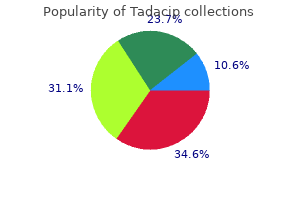
Tadacip 20 mg
Generation of peripheral B cells happens via two spatially and temporally distinct pathways thyroid erectile dysfunction treatment buy tadacip 20mg without a prescription. Developmental stage-specific shift in responsiveness to chemokines throughout human B-cell development erectile dysfunction australian doctor buy 20 mg tadacip fast delivery. Developmental switches in chemokine response profiles throughout B cell differentiation and maturation erectile dysfunction drug coupons cheap 20mg tadacip with amex. Quantitative aspects of cellular site visitors from the thymus to the periphery in mice most effective erectile dysfunction drugs buy 20mg tadacip overnight delivery. Mapping precursor motion through the postnatal thymus reveals specific microenvironments supporting defined levels of early lymphoid development. A murine early thymocyte developmental sequence is marked by transient expression of the interleukin 2 receptor. Interdependence of cortical thymic epithelial cell differentiation and T-lineage dedication. Promiscuous gene expression in thymic epithelial cells is regulated at multiple ranges. An autosomal locus inflicting autoimmune disease: autoimmune polyglandular disease kind I assigned to chromosome 21. Characterization of human thymic epithelial cell surface antigens: phenotypic similarity of thymic epithelial cells to epidermal keratinocytes. The epitopes targeted by the rheumatoid arthritis-associated antifilaggrin autoantibodies are posttranslationally generated on varied websites of (pro) filaggrin by deimination of arginine residues. Thymic dendritic cells and T cells develop simultaneously within the thymus from a standard precursor inhabitants. The importation of hematogenous precursors by the thymus is a gated phenomenon in regular grownup mice. Two developmentally distinct populations of dendritic cells inhabit the adult mouse thymus: demonstration by differential importation of hematogenous precursors beneath steady state conditions. Differential effects of peptide diversity and stromal cell type in positive and negative choice within the thymus. Functional and phenotypic analysis of thymic B cells: function within the induction of T cell negative selection. Resident B cells regulate thymic expression of myelin oligodendrocyte glycoprotein. Characterization of vascular adhesion molecules that will facilitate progenitor homing in the postnatal mouse thymus. Thymocyte emigration is mediated by lively movement away from stroma-derived components. Thymus organogenesis and molecular mechanisms of thymic epithelial cell differentiation. Gcm2 and Foxn1 mark early parathyroid- and thymus-specific domains within the growing third pharyngeal pouch. A developmental take a glance at thymus organogenesis: the place do the non-hematopoietic cells within the thymus come from Characterization of stromal cell populations in the growing thymus of regular and nude mice. Tracing of cells of the avian thymus via embryonic life in interspecific chimeras. Cutting edge: thymocyteindependent and thymocyte-dependent phases of epithelial patterning in the fetal thymus. Stepwise improvement of thymic microenvironments in vivo is regulated by thymocyte subsets. Early human T cell improvement: evaluation of the human thymus at the time of initial entry of hematopoietic stem cells into the fetal thymic microenvironment. Impact of unfavorable choice on the T cell repertoire reactive to a self-peptide: a big fraction of T cell clones escapes clonal deletion. Most lymphoid organ dendritic cell sorts are phenotypically and functionally immature.
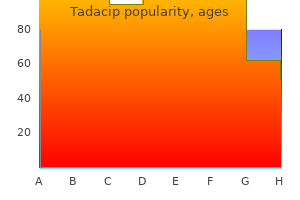
Discount tadacip 20mg visa
A key turning level came in 1948 and 1949 within the form of a e-book and a genetics article synthesizing all that was known in regards to the Production of Antibodies by Burnet and Fenner erectile dysfunction medication with high blood pressure buy tadacip 20mg amex. They proposed that tolerance-inducing antigens could be recognized by antibody on lymphocytes alongside a second receptor for a "self-marker psychogenic erectile dysfunction icd-9 discount tadacip 20mg overnight delivery. The particular stimulus (or antigenic determinant) designates which specific antibody shall be produced erectile dysfunction age range order 20 mg tadacip with amex. The nonspecific stimulus (or adjuvant factor) carries the power to stimulate cell proliferation impotence tcm order 20 mg tadacip mastercard, and is anxious with the quantity of antibody produced. In 1975, Moller revealed additional experimental and theoretical proof for this idea, naming it the "one nonspecific signal" mannequin. Chickens13 or mice14 exposed to foreign antigens in ovo or in utero were still totally capable of making antibodies towards those antigens. In their 1953 paper, Medawar crystallized the idea: "This phenomenon is the exact inverse of actively acquired immunity and we subsequently suggest to describe it as actively acquired tolerance. Talmage16 and Burnet17,18 independently arrived on the "one cell�one antibody" idea of clonal proliferation to explain acquisition of immunity. Clonal proliferation itself made the experiments possible, by increasing the frequency and the specificity of antigen-reactive cells so that they could be accurately enumerated, micromanipulated, and experimentally studied. Testing for the disappearance of self-reactive clones in tolerant animals was nonetheless like asking if a needle had been eliminated from a haystack. It was confounded for 30 years by the elemental technical barrier that antigenbinding lymphocytes are rare and heterogeneous in the preimmune repertoire. The Experimental and Conceptual Swing towards Clonal Deletion in the Nineteen Sixties and Nineteen Seventies Experiments have been carried out in the Nineteen Sixties and 1970s to see if lymphocytes able to binding self-antigens have been absent from the circulating repertoire, both by direct antigenbinding measurements, by polyclonally activating cells into antibody secretion in culture, or by immunizing with foreign antigens that resemble self-antigens. Lymphocytes with self-antigen binding antibodies could presumably be found,21 main many to question the thought of clonal deletion. We know now that many B cells in the preimmune repertoire bear antibodies which would possibly be polyreactive, binding with low and variable affinity to many various antigens together with self-antigens. In other circumstances, highaffinity receptors were isolated but the assays used confused real autoantibodies with antibodies that sure to misfolded, proteolytically cleaved, or posttranslationally modified "altered self. Cooper neatly bypassed the problem of various antigen affinity by displaying that therapy of growing chicks or neonatal mice with antibodies to the constant region of immunoglobulin (Ig)M utterly blocked B-cell improvement and antibody formation. This revised view was made poignantly by Miller when he acquired the inaugural Burnet Medal in 197135: "Specific tolerance can be induced much more readily in T cells than in B cells and, in plenty of instances, tolerance in B cells in vivo is simply not demonstrable. It could in fact turn out that tolerance to self-components is a property confined exclusively to the T cell population, tolerance in B cells being merely a laboratory artifice. In this model, tolerance might nonetheless be actively acquired within the B cell by deletion, anergy, or another mechanism that paralyzed antibody formation if it encountered antigen (signal 1) without receiving sign 2 from the helper T cell. As detailed within the following, modern molecular and mobile methods have established necessary roles in actively acquired self-tolerance for every of these three fundamental concepts. Similar studies were done utilizing different V-specific antibodies that correlated the absence of explicit V with the presence of self-antigens. One of the most well-liked models to consider tolerance in this way used different strains of mice that expressed minor histocompatibility antigens often identified as minor lymphocyte stimulatory (Mls) antigens. This group of molecules was outlined by Festenstein in the early 1970s76 and later proven to affiliate with endogenous retroviruses. Mice have been characterized as expressing Mls-1a, Mls-1b, or Mls-1c antigens, by the flexibility of T cells to generate a proliferative response in opposition to cells from totally different strains of mice. In this case, the place synthesis of the Mls-1a self-superantigen was restricted to radioresistant cells within the thymus, V6 + T cells that might usually be deleted in Mls-1a mice have been able to mature and to migrate from the thymus but were unresponsive to Mls-1a. T-Cell Affinity/Avidity Defines Thresholds for Positive and Negative Selection the observation that T cells have been positively chosen for selfreactivity during thymic improvement and in addition negatively chosen for self-reactivity drew into sharp focus the central paradox for actively acquired tolerance and immunity. Studies to consider the affinity/avidity fashions of thymocyte choice had been again dependent upon the development of new applied sciences. In the 1980s, Smithies and Capecchi reported a method to generate knockout mice, where the expression of an outlined gene was disrupted. Two groups demonstrated that different concentrations of the same agonist peptide promoted constructive selection at low concentrations and adverse choice at excessive concentrations. Regulatory T Cells are Selected by High Affinity/ Avidity Interactions Treg cells had been first recognized as a important population that prevented autoimmunity and arose during thymic development. Foxp3 was first identified by genetic mapping of an autoimmune mutation within the scurfy mouse pressure.
Graminis Rhizoma (Wheatgrass). Tadacip.
- Dosing considerations for Wheatgrass.
- What is Wheatgrass?
- How does Wheatgrass work?
- Ulcerative colitis; reducing cholesterol; anemia; diabetes; cancer; high blood pressure; preventing tooth decay; wound healing; preventing infections; removing drugs, metals, toxins, and cancer-causing substances from the body; and other conditions.
- Are there safety concerns?
Source: http://www.rxlist.com/script/main/art.asp?articlekey=97019
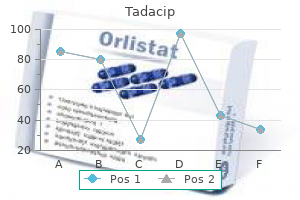
Discount 20mg tadacip visa
Thus erectile dysfunction medication for sale tadacip 20mg with mastercard, antibodies are among the many most versatile and extensively used types of reagents right now std that causes erectile dysfunction tadacip 20 mg cheap, and their use is constantly rising impotence vacuum pump purchase tadacip 20 mg amex. Understanding the basic ideas in antigen�antibody interactions thus has become essential not solely to an understanding of immunology but in addition to the effective use of those priceless molecules in plenty of different fields erectile dysfunction icd 9 2014 tadacip 20mg mastercard. Kabat, Henry Metzger, and Fred Karush for helpful ideas and discussion, and Dr. It may also be extended by evaluation of gene or protein expression at distinct intermediate levels. Critical processes, similar to D-J rearrangement and immunoglobulin (Ig) heavy chain expression, may also be mapped onto this framework. Progress in this work facilitates experiments that address additional points, such as identification of key regulatory interactions, developmental checkpoints, and the mechanism of B-lineage commitment. The following sections will cowl the websites of B-lineage improvement at totally different phases of ontogeny, then concentrate on what is understood about their improvement within the bone marrow of grownup mice, highlighting the operate of the pre�B-cell receptor and the crucial role of Ig heavy and lightweight chains in guiding development. Later sections will consider their differentiation into numerous specialized peripheral populations and emphasize insights into B-cell choice gained from varied transgenic fashions of tolerance. B cells in people and mice are produced throughout life, primarily in the fetal liver earlier than start and in the bone marrow after start. The complexity of this process is now obvious, and B-cell progenitor differentiation into a quantity of peripheral subsets with distinctive functions can be widely appreciated. This article will concentrate on B-cell development and performance in the mouse, touching more briefly on aspects of human B cells which may be comparable or distinctive, with a focus on immunodeficiency and B-cell neoplasias. It will conclude with a quick description of novel features of B-lymphocyte growth in different species, highlighting differences from development in mouse and human. Early Development Sites of B Lymphopoiesis during Ontogeny In the mouse, hematopoiesis occurs predominantly in the fetal liver previous to delivery, in the spleen just previous to and shortly after start, and within the bone marrow thereafter. Cells from this web site are able to longterm repopulation of lethally irradiated grownup recipients with all blood lineages. Thereafter, B-lineage cells develop largely in a wave, with earlier phases current at earlier times and later stage predominating at later instances, close to (and shortly after) delivery. One of the goals of classical hematology has been the delineation of differentiation pathways for various lineages of blood cells. There has been considerable progress in using the ordered expression of a diverse set of cell floor and inside proteins, some with recognized features, others whose roles are only suspected, to assemble a description of the intermediate phases that cells transit as they develop into B lymphocytes. This sort of pathway could be constructed by isolation and short-term culture of intermediate levels, permitting development to occur, which helps to define the order. Another distinction of fetal liver from bone marrow improvement within the adult is the absence of terminal deoxynucleotidyl transferase (TdT),10,11 an enzyme that mediates nontemplated addition of nucleotides on the D-J and V-D junctions of Ig heavy chain. The B-cell progeny of this early fetal wave may largely include B cells quite distinct from adult-derived cells, populating the B-1 subset. Over this similar period, B-cell growth shifts to the bone marrow and thereafter it continues for the lifetime of the animal. Phenotypic Progression of Developing B-Lineage Cells in Mouse Fetal Liver Analyzed at Different Days of Gestation. The purpose for this restriction has been intensively studied, and downregulation of the receptor for granulocyte�myeloid colony stimulating factor has been instructed to be a key event on this course of. Most cells growing in stromal cultures give rise only to B cells upon switch into mice, and the phenotype of those cells has been properly characterised. A"), concomitant with lowered expression of receptors for myeloid development factor receptors. On the other hand, it seems that initiation of Ig rearrangement is initiated sooner than some studies have indicated. Determination of Rag-1 transcriptional exercise on the single cell degree by a green fluorescent protein reporter, used for identification of the early lymphoid progenitor fraction,fifty three might present a key approach for such research. A: An strategy for purifying the earliest stage of B-lineage cells in mouse bone marrow. Bone marrow cells expressing cell surface proteins attribute of differentiated stages of T, myeloid, erythroid, and B lineages are depleted sequentially by electronic gating within the first three panels. B: Functional analysis of early B-lineage cells by in vivo competitors assay, exhibiting absence of myeloid or T-lineage era, but production of B-lineage cells from Fr.
Quality tadacip 20mg
This is finest exemplified by the short-lived anergic B cells that end result from an encounter with the H-2K b protein within the liver whereas en path to erectile dysfunction protocol download free buy discount tadacip 20 mg the spleen erectile dysfunction quiz buy 20 mg tadacip with mastercard. Reversal from anergy on this occasion may end result from the absence of liver-specific antigen within the spleen impotence with beta blockers generic 20 mg tadacip free shipping. In Ig-transgenic mice expressing an antibody towards erythrocytes erectile dysfunction protocol free copy generic tadacip 20 mg without prescription, enlargement of B1 cells relies upon upon their relative shielding from erythrocytes on this compartment476,477 and requires concurrent infection with pathogenic or commensal microorganisms. A related scenario occurs in Ig-transgenic mice expressing a low-affinity germline antibody in opposition to a carbohydrate epitope on the T-cell protein, Thy1, the place the B cells are arrested as anergic immature cells in the spleen, few reach the lymph nodes, however they accumulate as B1 cells in the peritoneal cavity and secrete anti-Thy1 IgM autoantibody. Remarkably, the induction of B1 cells and autoantibodies requires the Thy1 autoantigen and is abolished in Thy1-deficient mice. The first act has been to define the physiologic mechanisms of actively acquired tolerance. There are more likely to be totally new mechanisms revealed sooner or later, and answers are but to come about fundamental questions like how lymphocytes select alternative fates of demise, survival, or progress at a given tolerance checkpoint. Currently, this is an space of great activity, via genome-wide affiliation research of unparalleled dimension and the dawn of an thrilling period of entire exome and genome sequencing in patient cohorts. Analysis of B- and T-cell anergy has revealed the restrictions of cyclosporin and tacrolimus as blocking each lymphocyte activation and actively acquired tolerance, 236,450 and helped promote a shift to "tolerance sparing" immunosuppressive drugs like rapamycin and mycophenolate. They are a small step for many sufferers, however the clinical response that happens in a subset represents an enormous leap for mankind. These agents mark the start of the age when we perceive immunologic tolerance sufficiently to induce, restore, or droop it in sensible methods. This suppression, or "infectious tolerance" as it was originally termed, was antigen-specific, because the immune response to an unrelated antigen, horse purple blood cells, was not inhibited. Other studies5�7 during the Seventies supported the existence of T cell� mediated suppression. It remained potential that suppressor T cells had been actually cytotoxic cells that killed the helper or effector T cells. A cell surface marker that seemed to establish a suppressor cell-specific antigen was discovered in 1976. A(5R) mice or vice versa gave rise to an antiserum that seemed to react solely with suppressor cells. In addition to T cells that upregulate (help), different populations that downregulate (suppress), the immune response must exist. Once a normal immune response is initiated by antigenic stimulation, mechanisms must be in place to management the magnitude of that response and to terminate it over time. Downregulation should contribute to the homeostatic control of all immune responses serving to restrict clonal enlargement and effector cell exercise in response to any antigenic stimulus. An active mechanism of T-cell suppression can also be needed to control doubtlessly pathogenic autoreactive T cells. The major mechanism that leads to tolerance to self-antigens is thymic deletion of autoreactive T cells, but some autoreactive T cells could escape thymic deletion or acknowledge antigens that are expressed only extra-thymically. T-cell anergy1 and T-cell ignorance/indifference2 have been proposed as the first mechanisms used to control autoreactive T cells within the periphery, although these "passive" mechanisms for self-tolerance may not be enough to management doubtlessly pathogenic T cells. It was proposed greater than 40 years in the past that a definite subset of T cells is answerable for immune suppression. Although a strong theoretical basis exists for T cell�mediated suppression, this area of immunologic analysis has been suffering from controversy. The past decade has seen a resurgence of curiosity within the idea of T-cell suppression mediated by a distinct subset of T cells which might be uniquely outfitted to mediate suppressor activity. It was believed at that time that the antibody-producing B cell was rendered nonresponsive by exposure to the excessive focus of antigen. Soon after the existence of T cell�mediated suppression was appreciated, some studies suggested that interactions among a quantity of distinct T-cell subpopulations might be involved. Contrasuppressor T cells had no unbiased helper, suppressor, or cytotoxic activity on an immune response, but enhanced immune responses by stopping the downregulation mediated by suppressor cells.

Buy tadacip 20 mg on line
Instead erectile dysfunction protocol jason purchase 20 mg tadacip free shipping, dimerization is initiated by the interplay of antigen with the Fab arms erectile dysfunction vitamin d buy 20mg tadacip with amex, thus linking adaptive responses to effector cell triggering erectile dysfunction treatment rochester ny discount 20mg tadacip with amex. Of significance is the 1:1 stoichiometry of the complexes does erectile dysfunction get worse with age trusted 20 mg tadacip, which ensures that a single receptor binds to a single immunoglobulin molecule. Two binding sites on the receptor interact asymmetrically with two websites on the Fc molecule. The FcR inserts into the cleft fashioned by the two chains of the Fc molecule, burying a binding floor of 895 � for every binding website. Alterations in the Fc structure that reduce the cleft, corresponding to deglycosylation of IgG, inhibit FcR binding. Four distinct areas have been outlined in the Fc domains concerned in FcR interactions. The homologous regions for IgG are residues 234 to 239, 265 to 269, 297 to 299, and 327 to 332. Interactions of these residues occur with the carboxy-terminal domain 2 of the respective FcRs. In view of the similarities of these complexes and the homologies among the receptors and their ligands, an apparent query that arises concerns the molecular basis for specificity. Attempts to resolve that question have relied on mutagenesis studies of the ligands and area exchanges between receptors. The implications of these structural research are that the Fc area of IgG could additionally be selectively mutated to direct its binding to particular Fcg Rs. A sustained calcium inflow is associated with these functions, as is transcription of genes related to the activated state. Synergistic interactions between activation FcRs and toll receptors, mannose receptors, and other pattern-recognition molecules have additionally been reported in vitro and recommend that interaction between the innate and adaptive effector mechanisms of an immune response are involved in mediating environment friendly safety from microbial pathogens. With a single exception, FcRs affiliate with accent subunits that contain these signaling motifs. Ligands that rapidly dissociate from their receptors lead to nonproductive signaling complexes that fail to couple to downstream events and behave as antagonists. This two-step process is absolutely necessary to transduce the aggregation sign to a sustainable intracellular response. B: FcR signaling in macrophages is proven as an example of simultaneous triggering of activation and inhibitory FcRs. These mice had dramatically reduced ranges of autoreactive antibodies and have been protected from the development of fatal autoimmune disease. This speculation has been validated in models of collagen-induced arthritis and Goodpasture syndrome. These characteristics are indicative of Goodpasture syndrome, a human disease not beforehand modeled in an animal species. At present, a growing physique of information means that FcRs are certainly concerned in enhancement of the afferent response, by influencing antigen presentation and cognate T-cell interactions. The physiological response is thus the net of the opposing activation and inhibitory signaling pathways that each receptor triggers and is determined by the level of expression of every receptor and the selective avidity of the IgG ligand (see Table 24. A: Mice were injected with the identical amount of various 6A6 antibody isotypes, which acknowledge an integrin on mouse platelets and result in FcR-dependent clearance of platelets from the blood as observed by the drop in platelet depend after antibody injection. C: Mice have been injected with antitumor antibodies containing or missing branching fucose residues, thereby enhancing binding to activating FcRs and changing the A/I ratio (see text for details). Deletion of the mast cell inhibitory receptor glycoprotein 49B1 also results in enhanced IgE-induced anaphylaxis. All these animals displayed antigen-specific antibodies for IgE and IgGs, which indicates that the active anaphylaxis seen was attributed primarily to IgG antibodies. The absolute stage of surface expression of FcRs on mast cells is clearly of therapeutic significance in both IgE- and IgG-mediated inflammatory responses; modulation of g chain expression could thus characterize a model new therapeutic avenue for intervention in ailments corresponding to anaphylaxis and asthma. The mechanisms by which these antibodies trigger cytotoxicity in vivo have been investigated in FcR knockout mice. This is in preserving with the affi nities of these isotypes for their particular activating and the inhibitory receptor, which is in a position to decide antibody activity in vivo (see Table 24. In a passive protection mannequin of Cryptococcus neoformans �induced disease, passive immunization with mouse IgG1, IgG2a, and IgG2b antibodies resulted in safety in wild-type animals but not in FcRg chain�deficient animals. Deficiency of FcRg chain protected these mice from the pathogenic results of the anticollagen antibodies that were generated.
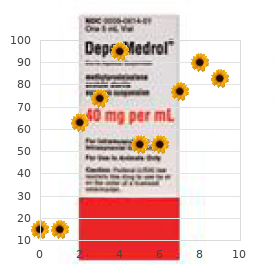
Purchase 20mg tadacip otc
The nervous system can also talk to different organ methods through the neuroendocrine organs erectile dysfunction stress discount 20mg tadacip free shipping, a humoral pathway that relies on the bloodstream to ship the fi nal sign what std causes erectile dysfunction purchase tadacip 20 mg fast delivery. As compared to erectile dysfunction pills images effective 20mg tadacip the neural communication pathway erectile dysfunction world statistics cheap 20 mg tadacip overnight delivery, the extra steps of hormone launch and transit by way of the circulatory system implies that neuroendocrinederived homeostatic regulation alerts are delivered rather more slowly than neural motion potentials. The major sign in both systems, however, is neural, because neuroendocrine signaling is initiated by neurons within the brainstem and hypothalamus that relay action potentials to the autonomic nuclei, and the pituitary gland, to regulate the discharge of pituitary hormones into the bloodstream. The voluntary nervous system permits the mind to consciously (or voluntarily) monitor the environmental stimuli and respond to it. The autonomic nervous system maintains the physiologic steadiness of varied visceral organs techniques, corresponding to respiratory, endocrine, cardiovascular, gastrointestinal, etc. The autonomic nervous system is further subdivided into sympathetic nervous system and the parasympathetic nervous system. The sensory (afferent) neural path relays data to the central nervous system. Sensory neurons reply to strain, vibration, temperature, and different molecular signals (eg, taste) that set off motion potentials that travel to the spinal twine or brainstem. These reflex principles governing the cardiovascular and different comparatively accessible organ system had been established a lengthy time ago. Only fairly recently has it turn out to be attainable to understand how these reflex principles operate in the more diffuse immune system. The the rest of this chapter evaluations the neural and humoral mechanisms underlying the reflex control of immune homeostasis by the nervous system. These anatomic sites are richly innervated by the autonomic nervous system via neurons that are adrenergic, cholinergic, and peptidergic. They enter the lymphoid organs by touring with the arterial vasculature; upon entering the tissue, they type networks that distribute to fields of lymphocytes and macrophages within the parenchyma. Innervation of lymphoid tissue is regional, primarily found in T-cell� and plasma-cell�rich zones, and missing in nodular regions and zones of maturing B cells. A neuron, the essential signaling unit of the nervous system, is comprised of a cell physique containing the nucleus, dendrites that primarily receive chemical message from other neurons, an axon that may lengthen for important length, and transmits electrochemical message to different cells. Three forms of neurons comprise the neural reflex circuit: sensory neurons, interneurons, and motor neurons. The sensory neurons respond to stimulation from exterior or inner environment and transmit alerts to the central nervous system. Motor neurons transmit information from the central nervous system to the periphery. Interneurons present connections between sensory neurons and motor neurons, as a result of they obtain signals from the sensory nerves and project the outgoing indicators via their axons to the dendrites of the motor neurons. In a neural reflex, which operates extremely shortly, the indicators are projected back to the organs via neuronal motion potentials. In a neuroendocrine reflex circuit, the efferent neurons project to the hypothalamic-pituitary-adrenal axis, which in flip regulates circulating hormone ranges over more prolonged durations of time. A useful instance of reflex circuits that keep homeostasis of organ perform is the acute neural regulation of coronary heart fee and the chronic neuroendocrine regulation of blood stress. The coronary heart price control circuit begins with pressuresensitive neurons that transmit details about heart rate to interneurons within the brainstem. These relay data to efferent brainstem nuclei that activate both adrenergic or cholinergic nerves that project back to the heart. The descending neural indicators both improve or decrease heart fee in response to deviations from the center price setpoint as established in the brainstem. Blood pressure additionally activates sensory neurons, which initiate alerts that modulate the renin-angiotensin system, and the hypothalamic pituitary axis. These neuroendocrine responses set up hormone levels that maintain continual blood pressure levels. Immunohistochemical analysis of splenic nerve endings (synaptophysin, red) in direct contact with lymphocyte (choline acetyltransferase�enhanced green fluorescent protein+, green) in the white pulp of the spleen. Thus, neurotransmitter release converts the electrical indicators propagated along neurons to the immune system into molecular or pharmacologic alerts that exert discrete action on the responding immunocompetent cells. The molecular products of an immune response significantly affect the remodeling of nerve fibers and the expression of neurotransmitter receptors in lymphoid organs. Additionally, systemic or regional inflammatory challenges lead to enhance in nerve fiber distribution in the lymphoid organs similar to thymus, lymph nodes, and spleen. Thus, the changing milieu within the immune system organs supplies necessary alerts that prune or expand the neural network to these organs.
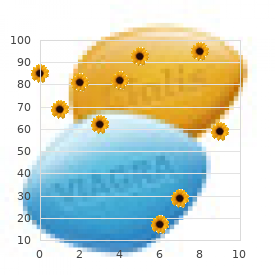
Discount tadacip 20 mg
Complete fusion of precipitin lines with no spurs is identified as a line of identification impotence word meaning order tadacip 20mg with amex, indicating that the antigen in every properly reacts with all of the antibody capable of reacting with antigen within the other properly erectile dysfunction treatment herbal remedy discount tadacip 20 mg mastercard. When a mixed antigen sample is placed in a single well and pure antigen b is positioned within the other well erectile dysfunction and injections discount tadacip 20mg with visa, antiserum to a plus b offers the sample shown impotence essential oils tadacip 20 mg otc. Two precipitin lines form with the left well and one precipitin line with the right nicely. The line of complete fusion allows us to establish the second band as antigen b; the first band is antigen a. From their relative distance of migration, we are ready to conclude that antigen a is in excess over antigen b, assuming their diffusion coefficients are comparable and each antibodies are present in equal quantities. Sensitivity may be elevated by use of radioactive antigen and detection of the precipitate by autoradiography. In step one, electrophoresis separates the check antigens according to charge and dimension, in impact, separating the ori- gin of diffusion of various antigens. This is equivalent to having every antigen begin in a special well, as shown in the right-hand panel. A horizontal trough is then cut into the agar and fi lled with antiserum to all the components. Immunodiffusion happens between the separated antigens and the linear source of antibody. The outcomes for a mix of three antigens approximate these proven for three antigens in separate wells. The resolution of every band is somewhat decreased as a outcome of widening of the origin of diffusion during electrophoresis. However, the immunodiffusion of unseparated human serum proteins, for example, is tremendously facilitated by prior electrophoresis. However, prior electrophoresis makes it attainable for every electrophoretic species to make its personal precipitin line. Monospecific antiserum could be placed in a parallel horizontal trough so that each band of precipitation could be recognized. Immunoelectrophoresis is commonly used to diagnose myeloma proteins in human serum. The unknown serum is electrophoresed, adopted by immunodiffusion towards antibodies to human Ig heavy or light chains. At this similar electrophoretic mobility, a precipitin line with anti-, however not anti-, reactivity strongly suggests the prognosis of myeloma or monoclonal gammopathy, as these proteins arise from a single clone that synthesizes only one gentle chain. All normal electrophoretic species of human Igs include both light chain isotypes, although exceeds by the ratio of two:1 in people. A sample containing a number of components is electrophoresed in an agarose gel, separating the antigens in the horizontal dimension. Immunodiffusion between the separated antigens and the trough is equal to having separate wells, every with a different antigen. Sera from the affected person or regular particular person have been positioned in the round wells and electrophoresed. Antisera have been then positioned within the rectangular troughs and immunodiffusion proceeded perpendicular to the direction of electrophoresis. The abnormally sturdy response with anti-immunoglobulin (Ig) G and anti-, however no reaction with anti- antibodies, indicate a monoclonal protein (IgG,), as polyclonal Ig should react with both anti� light-chain antisera. Failure to type a band with anti-IgM and a decreased band with anti-IgA present typical reduction of regular Igs on this illness. Hemagglutination and Hemagglutination Inhibition Hemagglutination A extremely sensitive method yielding semiquantitative values for the interaction of antibody with antigen involves the agglutination by antibodies of purple blood cells coated with the antigen. Untreated pink blood cells are negatively charged, and electrostatic forces maintain them apart. Untreated red blood cells are simply coated with polysaccharide antigens, which they adsorb readily. After tanning, the uptake of some protein antigens is good, giving a delicate reagent, whereas for others it tends to be fairly variable; coating pink blood cells has been the limiting issue in the usefulness of this method for sure antigens. Apparently, barely aggregated or partially denatured protein antigens are adsorbed preferentially.
References
- Saito F, Yutani C, Imakita M, et al. Giant cell pneumonia caused by varicella zoster virus in a neonate. Arch Pathol Lab Med 1989;113(2):201-3.
- Louhichi N, Triki C, Quijano-Roy S, et al. New FKRP mutations causing congenital muscular dystrophy associated with mental retardation and central nervous system abnormalities. Identification of a founder mutation in Tunisian families. Neurogenetics. 2004;5(1):27-34.
- Yurdakul T, Gokce G, Kilic O, et al: Transurethral resection of ejaculatory ducts in the treatment of complete ejaculatory duct obstruction, Int Urol Nephrol 40:369n372, 2008.
- Bloch C, Richard JL. Risk factors for atherosclerotic diseases in the Prospective Parisian Study. I: Comparison with foreign studies. Rev Epidemiol Sante Publique 1985;33:108.
- Kuypers DR, Verlede- G, -aese-s M, et al. Drug i-teractio- betwee- mycophe-olate mofetil a-d rifampi-: possible i-ductio- of uridi-e diphosphate-glucuro-osyltra-sferase. Cli- Pharmacol Ther. 2005;78:81-88.

